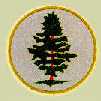|
- Prepare a field notebook, make a collection, and identify 15 species of trees and wild shrubs in a local forested area. Include a written description of:
- Identifying characteristics of leaf, twig, and fruit samples.
- The habitat in which these trees or shrubs are found.
- Chief ways each tree or shrub is used by human and wildlife.
- The forest's successional stage, what its history has been, and what its future is.
- Do ONE of the following:
- Collect and identify wood samples of 10 species of trees. List several ways each species of wood can be used.
- Find and examine several stumps or logs that show variations in growth rate in their ring patterns. Prepare a field notebook describing their location and discuss possible reasons for the variations.
- Be able to do the following:
- Describe contributions forests make to:
- Our economy in the form of products.
- Soil protection and increased fertility.
- Clean water.
- Clean air.
- Wildlife
- Recreation
- Tell which watershed or other source your community relies on for its water supply.
- Be able to describe what forest management means, including:
- Multiple-use management
- Even-aged and uneven-aged management and silvicultural systems associated with each type.
- Intermediate cuttings.
- How prescribed burning and related forest management practices are used.
- Do ONE of the following:
- Visit a managed public or private forest area with its manager or someone familiar with it. Write a brief report describing:
- The type of forest.
- The management objectives.
- The forestry techniques used to achieve the objectives.
- Take a trip to a logging operation or wood-using industrial plant and write a brief report describing:
- The species and size of trees being harvested or used.
- Where the trees are going to or coming from.
- What products are made from the trees or at the plant.
- How the products are made.
- How the products are used.
- How waste materials from the logging operation or plant are disposed of or utilized.
- Be able to do the following:
- Describe the damages to forests that result from:
- Wildfire.
- Insects.
- Tree disease.
- Overgrazing.
- Improper harvest
- Tell what can be done to reduce these damages.
- Tell what you should do if you discover a forest fire and how to control it.
- Do ONE of the following:
- Assist in carrying out a project that meets one or more of these objectives: timber stand improvement, watershed improvement, wildlife habitat improvement, recreation are improvement or range improvement.
- Take a part in a forest fire prevention campaign in cooperation with your local fire warden, forester, or counselor.
- Visit with one of more local foresters and write a brief report including education, qualifications, career opportunities, and objectives relating to forestry.
|
|
